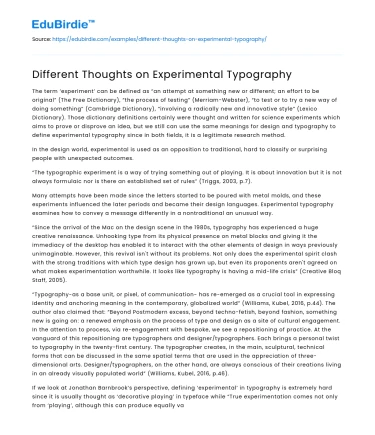The term ‘experiment’ can be defined as “an attempt at something new or different; an effort to be original” (The Free Dictionary), “the process of testing” (Merriam-Webster), “to test or to try a new way of doing something” (Cambridge Dictionary), “involving a radically new and innovative style” (Lexico Dictionary). Those dictionary definitions certainly were thought and written for science experiments which aims to prove or disprove an idea, but we still can use the same meanings for design and typography to define experimental typography since in both fields, it is a legitimate research method.
In the design world, experimental is used as an opposition to traditional, hard to classify or surprising people with unexpected outcomes.
Save your time!
We can take care of your essay
- Proper editing and formatting
- Free revision, title page, and bibliography
- Flexible prices and money-back guarantee
“The typographic experiment is a way of trying something out of playing. It is about innovation but it is not always formulaic nor is there an established set of rules” (Triggs, 2003, p.7).
Many attempts have been made since the letters started to be poured with metal molds, and these experiments influenced the later periods and became their design languages. Experimental typography examines how to convey a message differently in a nontraditional an unusual way.
“Since the arrival of the Mac on the design scene in the 1980s, typography has experienced a huge creative renaissance. Unhooking type from its physical presence on metal blocks and giving it the immediacy of the desktop has enabled it to interact with the other elements of design in ways previously unimaginable. However, this revival isn't without its problems. Not only does the experimental spirit clash with the strong traditions with which type design has grown up, but even its proponents aren't agreed on what makes experimentation worthwhile. It looks like typography is having a mid-life crisis” (Creative Bloq Staff, 2005).
“Typography-as a base unit, or pixel, of communication- has re-emerged as a crucial tool in expressing identity and anchoring meaning in the contemporary, globalized world” (Williams, Kubel, 2016, p.44). The author also claimed that: “Beyond Postmodern excess, beyond techno-fetish, beyond fashion, something new is going on: a renewed emphasis on the process of type and design as a site of cultural engagement. In the attention to process, via re-engagement with bespoke, we see a repositioning of practice. At the vanguard of this repositioning are typographers and designer/typographers. Each brings a personal twist to typography in the twenty-first century. The typographer creates, in the main, sculptural, technical forms that can be discussed in the same spatial terms that are used in the appreciation of three-dimensional arts. Designer/typographers, on the other hand, are always conscious of their creations living in an already visually populated world” (Williams, Kubel, 2016, p.46).
If we look at Jonathan Barnbrook’s perspective, defining ‘experimental’ in typography is extremely hard since it is usually thought as ‘decorative playing’ in typeface while “True experimentation comes not only from ‘playing’, although this can produce equally valid experiments, but being aware of the communication problems and solving them in a creative way in practice” (Triggs, 2003, p.89).
Michael Worthington holds the view that “True experimentation means taking risks. Not knowing the outcome but trying something that you think will be successful, but you have no proof” (Triggs, 2003, p.115).
For Elliott Peter Earls, all the typographic forms come from historical interpretation. If the type is not in an accepted norm historically, it means that it is experimental (Triggs, 2003, p.214).
For David Carson, experimental typography is something which have not been tried before. It should be something that has not been seen or heard. Carson's career, starting with personal research, is the most famous, inspiring graphic designer of the nineties, an experimental typographer, a pioneer in magazine design. Carson, in page designs, rejected grid system, conventional order, readability rules and visual hierarchy. Page numbers, names or descriptions of images, often written in very small fonts, were the elements that attract attention in his designs.
So, these are the various thoughts on experimental typography that I have highlighted in this essay.






 Stuck on your essay?
Stuck on your essay?

